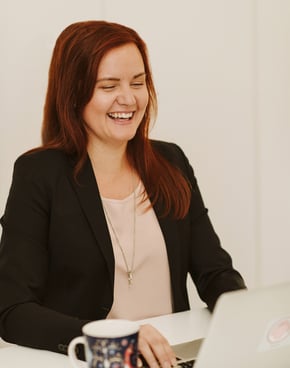The headings are the ones I wrote down from Johannes’ tips. The descriptions, on the other hand, are an explanation of my interpretation, my own experiences and my readings.
1. Test your cortisol levels
Cortisol is the so-called stress hormone. The amount of cortisol in your blood shows how stressed you are. Starting with testing your stress levels is therefore a reasonable first step. However, I felt that I wanted to take some other action before I did it myself.
Therefore, it took a few months until I did the test myself. Personally, I chose Werlabs, since I have used their packages before. However, I decided to try a new package – the Karin Björkegren Jones package. It seemed exciting because thyroid and stress are often related, and that package focuses precisely on the thyroid.
2. Go for a massage regularly
Going for a regular massage was a bit of a no-brainer. I love going for a massage! Since May I have been going 1-2 times a month.
Johannes talked about massage once a week. It is certainly the ultimate, but I chose to settle a little lower for both temporal and financial reasons. The massage mainly helps to relieve tension in the neck which is where stress often settles. This means that if the massage hurts, you are probably stressed. Massage is thus both good for sensing the level of stress and helping to release it.
3. Get a foot massage
Foot massage was something else that was recommended to relax. I have only tried foot massage once, except as part of a full body massage. It was nice – but for me, a full-body massage is what works.
4. Give up or reduce your caffeine
Giving up caffeine often improves sleep. I also think you get a healthier relationship with your energy levels. Starting the day with a coffee is probably some kind of indication that you have slept too little. In addition, it takes about 6 hours for the body to break down caffeine, which means that you should preferably not drink coffee after 2 pm if you go to bed at 10 pm.
I try not to wake up by the alarm clock, but by myself. Because of that, I think it’s more okay to start the day with a coffee. In addition, I try to have the last cup of coffee at lunch. So I have not given up coffee, but I have a little stricter rules around it.
5.Use Noise-canceling headphones
Today, many of us work in open landscapes. This means that we are constantly exposed to lots of impressions, which means that we go a bit full-fledged all the time. By using noise-canceling headphones, we turn off some of the sound and get more calm. I used noise-canceling headphones from Bose even before Johannes’ lecture, so I have continued with that.
6. Avoid open office landscapes
Open office landscapes are generally a problem. There are plenty of studies that show that they reduce efficiency and increase stress. We work in a smaller office, so even if it is open landscape, the negative effect will not be as great.
7. Tune in with your stomach
The fact that the stomach starts to “act strange” is often an early sign of being stressed. Therefore, one should “listen” to one’s stomach and take action if it is not well. For example, by eating:
Anti-inflammatory diet and skip gluten
One thing that has worked for many people who have stomach problems is eating anti-inflammatory and skipping gluten. I myself have not tried or had so much trouble with this – but gluten is not a huge part of my diet.
Probiotika
Probiotics are healthy gut bacteria. By eating probiotics, the stomach can also feel better.
Ashwagandha
Ashwagandha is a medicinal herb that is said to reduce cortisol levels. Therefore, it may be a dietary supplement to consider.
Glysin
Another dietary supplement is glycine. It is used by many who are training to improve recovery, but should also improve sleep quality and contribute to better heart health. That in turn contributes to recovery.
8. Stretch or go to yoga frequently
I’ve probably never stretched as much as this period of time. Also, I have found a type of yoga I like – bikram yoga. Do you think yoga feels strange? Ignore the exercises for a while and reflect on the fact that yoga gives you 60-90 minutes to focus on breathing. That alone is a reason to do yoga.
9. Quit high intensity workouts
Quitting high intensity training for a period of time was the biggest drastic change I made after Johannes’ lecture. I went from going to Barry’s (solely high-intensity workouts) 2-3 times a week, to ban myself from going to Barry’s. Instead, I began to take long walks and do yoga.
The explanation behind Johannes’ tip is that when exercising, cortisol levels should be raised, and then lowered to below the initial level after the workout. However, if you are stressed and have elevated cortisol levels, this will not work properly. Instead, it may be that you get the opposite effect – that is, the cortisol levels are higher after the workout.
10. Do long, relaxed workouts
The alternative to hard cardio training is long low paced workouts, which help the body unwind. Swimming slowly, walking, or similar activities is preferable during periods of high stress, as it also contributes to relaxation.
11. Try Cognitive behavioral therapy
This is the only thing on the list that I have not tried nor am super curious about. Johannes recommended it because it can help with anxiety. However, I myself have nothing specific I want help with. That’s why I wouldn’t know what to talk about during a conversation, which makes it less interesting to me.
12. Begin meditating
Have you never tried meditating? Do it. Have you tried but not stuck? Try again. Have you tried, stuck, but not got in the routine? Then we’re in the same boat.
I love it and know it works, but it’s not a natural part of my everyday life. I’m working on it!
13. Listen to Holosync before going to sleep
Holosync, or bilateral waves, was something I had never heard of before. That means I had to try it!
Holosync is a type of meditation that involves listening to a particular series of recorded sounds. That in itself should make meditation 8 times more effective. This has been much more soothing than I could have imagined. However, I haven’t gotten into a routine of doing it yet – but I haven’t prioritized that either.
14. Prioritise Sleep
Sleep enough – try to get 39-45 sleep cycles in a week, Johannes told us that a sleep cycle is about 1.5 hours. I think that was super interesting! Sleep does wonders for my performance and my well-being. Therefore, this is probably my highest priority.
A couple of years ago, I measured my sleep in relation to how I was feeling, during a whole year. Then I realized that I absolutely needed a total of 35 hours of sleep the night before a working day – that is, the nights that are between Sunday and Friday. In addition, I could not have two nights in a row with too little sleep. This fits in well with the example of sleep cycles above, which stays between 8-10 hours of sleep per night.
15. Visit a chiropractor
Until September of this year, I had never been to a chiropractor. I have always been afraid of cracking, and instead been to naprapaths and masseurs. However, after suffering from lower back pain for almost 9 months and trying all other types of treatments, I finally decided to give it a try. Surprisingly enough, it took 3 treatments focusing on my neck, before the pain was almost gone! Imagine that all this tension was in the neck – but it was the lower back that hurt. Had I listened to Johannes tips earlier and gone for more massages, it might not have happened.

